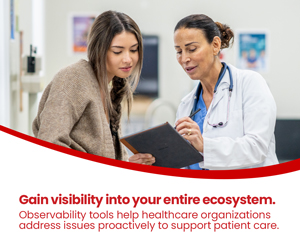Healthcare Security That Goes Beyond Monitoring
Why wait for the billion-dollar outage to justify improving your IT operations and security? “I always tell customers, reduce the risk from the start,” says Beckendorf.
Several years ago, a well-known airline’s scheduling and crew-management application failed, stranding hundreds of thousands of passengers and forcing the cancellation of thousands of flights. This cost the company over $100 billion in lost revenue.
“The airline had been warned about its limited visibility into this critical application beforehand. And the decision to avoid a relatively modest observability investment of about $2 million ultimately cost the company hundreds of times more,” he says.
In a healthcare setting, the consequences could be even worse with patient outcomes on the line.
The Benefits of Observability for Healthcare Organizations
If teams are skeptical about making the investment, Beckendorf says, observability offers healthcare organizations a slew of benefits, including:
- Reduced downtime and faster resolution. “By correlating telemetry data across applications, infrastructure and networks, teams can cut mean time to identification and mean time to resolution,” says Beckendorf.
- Predictive insights. Observability enables organizations to spot concerning trends such as transaction latency or resource exhaustion before outages occur.
- Reduced costs. Consolidating overlapping tools reduces waste and complexity. “I worked on one project that was all about tool rationalization. We reduced a client’s portfolio from 130 tools to 67, saving nearly $20 million annually,” he says.
- Improved digital experience. Observability ultimately benefits the end user because there’s speed and ease of use with uptime and smooth service.
READ MORE: Here are the top five healthcare challenges solved by observability tools.
Understanding an Observability Framework
“At CDW, we frame observability maturity as five levels,” says Beckendorf.
Level 1 is monitoring. At this level, teams pinpoint where issues occur, he says. “IT teams can detect whether systems are up or down, network engineers watch network alerts, database admins monitor queries, and so on.”
Level 2 is early observability. “At Level 2, organizations begin to unify telemetry data and correlate signals across domains,” Beckendorf says. “Instead of simply asking what’s broken, teams can begin to answer, why is it breaking?”
“By Levels 3 and 4, organizations achieve richer correlation, governance and, in some cases, predictive capabilities,” he says.
Level 5, the ultimate goal for many, is automation and self-healing, although Beckendorf notes that the costs to reach Level 5 may outweigh the benefits: “Typically, only hyperscale operators like AWS or Netflix-level businesses need this top tier.”
Most organizations today hover around Level 1, but they’d be far better protected between Levels 2 and 3. To get started, they should plug known blind spots, such as unreliable network visibility or gaps in application telemetry, before aiming for predictive, AI-driven dashboards.
“Focus on critical workloads that directly impact revenue, compliance or customer trust; for example, electronic medical record systems in healthcare, core banking applications in finance, or reservation systems in travel. All of these demand deeper visibility,” he says.
This is where prioritization is important. For instance, legacy applications that see minimal use may not warrant the same investment.












